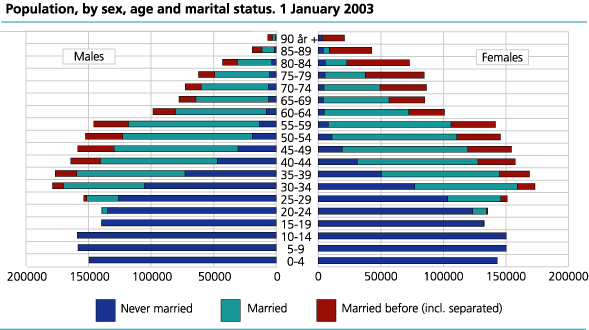Content
Published:
This is an archived release.
Due to immigration population increased
At the end of 2002 there were 4 552 200 residents in Norway, an increase of 28 000 from 2001 - 0.62 per cent. While the net immigration from abroad increased the rest of the population declined.
The population increased by 7 500 more than in 2001. This is the highest increase during the past 30 years, with the exception of 1998 and 1999. Preliminary figures show that he surplus of births was 10 700, which is the lowest surplus of births since 1987. If we do not take immigration into consideration, the population increase in 2002 would only have been 0.24 per cent. The increase of immigrants to Norway in 2002 could be related to the shorter time the Norwegian Directorate of Immigration used to handle the individual applications of residency, especially those associated with family reunion.
Higher population increase in urban areas
The municipalities showing a higher population increase in 2002, were those closer to the cities whereas the population growth was less in those further away from larger urban areas. It has to be taken into consideration that many of the rural municipalities have relatively few inhabitants, so small changes can easily make a large difference.
Many children in Rogaland, most old people in Hedmark and Sogn og Fjordane
When there are sudden and large changes in age patterns, it will eventually have consequences for the society. Different age groups require different services. In 2002 we can easily notice differences in the age composition in the counties. Seen in connection with the total number of people living in each county, Rogaland had the largest proportion of pre-school children, 8.8 per cent. The number for Akershus and Finmark was 8.4, while the average for Norway was 7.8 per cent. At the same time, these counties had the lowest percentage of people older than 80 years. Hedmark, Telemark and Oppland had the lowest percentage of pre-school children. Hedmark and Sogn og Fjordane had the highest percentage of people older than 80 years with as many as 5.5 per cent. The average for Norway was 4.5 per cent.
Few changes in marital patterns
As for the last years, in 2002 fewer couples married while the number of couples who remained not married increased. The group for "not married" increased by 3 000. Compared with figures from 2001, no changes in per cent occurred. At the end of the year 2002, 49 per cent of Norway's inhabitants were not married, 37 per cent married and 14 previously married. It is important to notice that cohabitant partners are not taken into consideration, and these are grouped as "not married".
At the end of 2002 about 2 300 were registered as partners in Norway, an increase of about 200 from 2001. 1 400 were men and 900 women.
The statistics can also to be found in Statbank where users can produce their own tables.
Tables:
- Table 1 Population, by marital status, sex and age. 1 January 2003
- Table 2 Population, by age. County. 1 January 2003
- Table 3 Population, by age. County. 1 January 2003. Per cent
- Table 4 Population, by sex, age and marital status. 1 January 2003
- Table 5 Østfold
- Table 6 Akershus
- Table 7 Oslo
- Table 8 Hedmark
- Table 9 Oppland
- Table 10 Buskerud
- Table 11 Vestfold
- Table 12 Telemark
- Table 13 Aust-Agder
- Table 14 Vest-Agder
- Table 15 Rogaland
- Table 16 Hordaland
- Table 17 Sogn og Fjordane
- Table 18 Møre og Romsdal
- Table 19 Sør-Trøndelag
- Table 20 Nord-Trøndelag
- Table 21 Nordland
- Table 22 Troms
- Table 23 Finnmark
- Table 24 Population, by age. Per cent. Municipality. 1 January 2003
- Table 25 Mean population, by marital status, sex and age. 2002
- Table 26 Population by sex and age. Oslo. Urban district. 1 January 2003
- Table 27 Population, by age. Per cent. Oslo. Urban district. 1 January 2003
- Table 28 Population by sex and age. Stavanger. Urban district. 1 January 2003
- Table 29 Population, by age. Per cent. Stavanger. Urban district. 1 January 2003
- Table 30 Population by sex and age. Bergen. Urban district. 1 January 2003
- Table 31 Population, by age. Per cent. Bergen. Urban district. 1 January 2003
- Table 32 Population by sex and age. Trondheim. Urban district. 1 January 2003
- Table 33 Population, by age. Per cent. Trondheim. Urban district. 1 January 2003
Contact
-
Magnus Haug
E-mail: magnus.haug@ssb.no
tel.: (+47) 40 81 14 91
-
Karstein Sørlien
E-mail: karstein.sorlien@ssb.no
tel.: (+47) 47 70 16 35
-
Linn Krokedal
E-mail: linn.krokedal@ssb.no
tel.: (+47) 95 47 97 47
-
Anders Sønstebø
E-mail: anders.sonstebo@ssb.no
tel.: (+47) 46 66 37 74
-
Espen Andersen
E-mail: espen.andersen@ssb.no
tel.: (+47) 92 61 00 46
-
Statistics Norway's Information Centre
E-mail: informasjon@ssb.no
tel.: (+47) 21 09 46 42
-
Oppdrag befolkningsstatistikk
E-mail: befolkning@ssb.no

